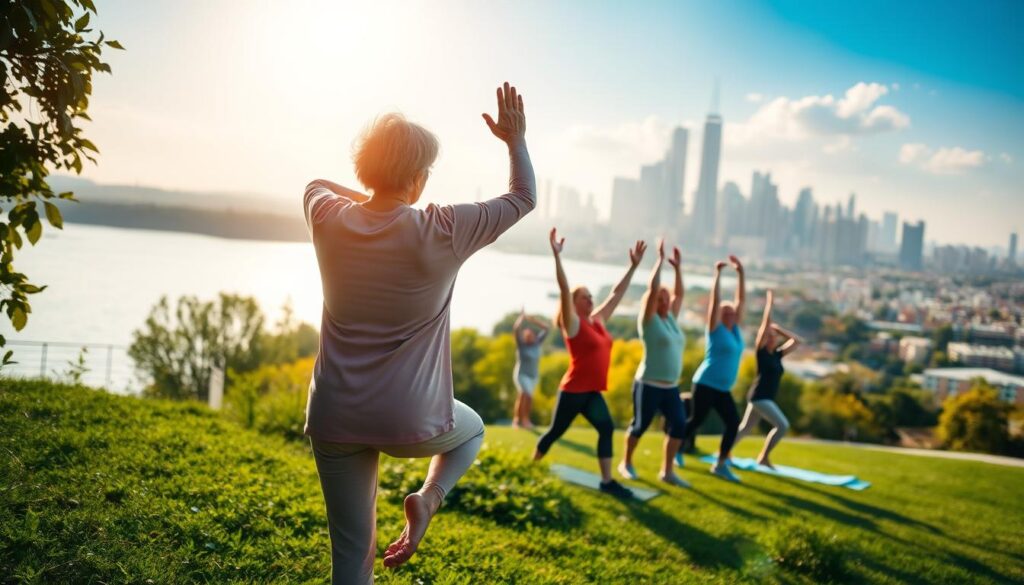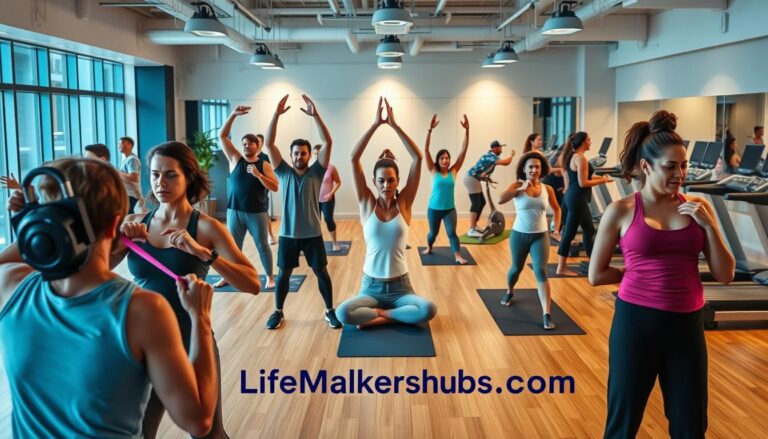Unleash Your Best Self: The Health Upsides of Exercise
Regular exercise is more than a routine—it’s a key to your overall well-being. The health benefits of exercise include preventing weight gain and lowering risks of chronic diseases like heart conditions and diabetes. The U.S. Department of Health and Human Services says that just 150 minutes of moderate activity a week can change your life.
By moving your body, you improve your mood, strengthen muscles, and sleep better. This shows that the importance of physical activity is clear.
Exercise is good for both your body and mind. It helps balance calories, supports heart health, and reduces stress hormones. From better sleep to sharper focus, physical activity shapes your daily life.
Whether it’s a brisk walk or a strength workout, every effort leads to a healthier, more energized life.
Key Takeaways
- 150–300 weekly minutes of moderate activity align with expert guidelines for optimal health.
- Exercise lowers heart disease risk by improving cholesterol and blood pressure.
- Mental health benefits include reduced anxiety and improved mood through brain chemical changes.
- Sleep quality and energy levels improve with consistent physical activity.
- Even small bouts of exercise, like 5 minutes, offer measurable health advantages.
Introduction to the Health Benefits of Exercise
Moving your body is more than just getting fit. It’s a key to better health. Let’s look at how exercise improves your physical and mental health, starting with the basics.
What Is Exercise?
Exercise is any activity that works your muscles and burns calories. It can be as simple as a brisk walk or as fun as a dance class. The Centers for Disease Control and Prevention (CDC) suggests 150–300 minutes of moderate exercise each week. This can be activities like cycling or swimming. Or, it can be shorter, more intense workouts like running.
Even daily chores like gardening or cleaning count too. They help you reach your weekly exercise goal.
Why It Matters
Not exercising can lead to serious health problems. Here’s why it’s so important:
- Reduces anxiety by 30% and sharpens focus in children and adults.
- Cuts heart disease risk by improving cholesterol and lowering blood pressure.
- Prevents 8 types of cancer, including breast and colon, by boosting immunity.
- Lowers diabetes risk by enhancing insulin sensitivity and blood sugar control.
Science proves that active adults live longer. Even small actions, like a 15-minute walk each day, offer big benefits. These include better sleep and stronger bones. Exercise is not a luxury—it’s a daily necessity your body needs.
Physical Benefits of Regular Exercise
Regular movement is more than just a workout—it’s a key to lifelong health. It affects everything from your heart to your bones. Fitness perks kick in the moment you start moving. Let’s see how exercise changes your body’s foundation.
Improved Cardiovascular Health
Exercise is great for your heart. It makes this vital organ stronger, lowers blood pressure, and boosts blood flow. The benefits of regular exercise include less bad cholesterol and more good cholesterol. This can cut stroke and heart disease risks by up to 30%, as the American Heart Association suggests.
Strengthened Muscles and Bones
Exercises like weightlifting or yoga build muscle and strengthen bones. This helps fight age-related muscle loss. Bone density goes up, reducing osteoporosis risk. Women who lift weights see a 36% drop in hip fracture risk. Stronger bones mean fewer injuries and better mobility as you age.
Weight Management
Exercise helps balance your metabolism, burning calories and preventing weight gain. Mixing cardio with strength training keeps your body composition stable. Even just 30 minutes a day can help prevent obesity-related diseases like diabetes.
- 30% lower risk of coronary heart disease
- 40% reduced type 2 diabetes risk
- 25% lower chance of breast cancer
Every workout brings these fitness perks. Start with something simple, like a daily walk or a quick routine at home. Your body will adapt, and the benefits will grow over time. Focus on being consistent, and you’ll see big changes in your health, from stronger bones to a healthier heart.
Mental Health Improvements
Exercise isn’t just for building muscles. It’s also a powerful tool for mental clarity and emotional balance. The positive effects of working out reach your brain, helping you manage stress and sharpen focus. Let’s dive into how movement shapes your mental landscape.
Reducing Stress and Anxiety
When you move, your body lowers cortisol, the stress hormone. A 2019 Harvard study showed that regular exercise cuts major depression risk by 26%. Even a single session can calm your nervous system. Here’s how it works:
- Activates the parasympathetic nervous system to counter stress responses
- Triggers endorphin release for natural mood lifts
- Reduces inflammation linked to anxiety symptoms
Boosting Mood and Cognition
Exercise sparks neurochemical changes that boost focus and emotional resilience. Here’s the science:
- Increases serotonin and dopamine, lifting mood and focus
- Enhances hippocampal volume, key for memory and learning
- Matches antidepressants in treating mild to moderate depression without side effects
“Physical activity is one of the most effective ways to improve mental health.” — CDC Mental Health Guidelines
| Exercise Type | Mental Health Impact |
|---|---|
| Walking | Reduces rumination by 22% (Stanford study) |
| Yoga | Cuts anxiety symptoms by 12% in 8 weeks |
| Team sports | Boosts social connections and self-esteem |
Even small efforts count: 30 minutes of brisk walking three days a week can impact of exercise on health by improving sleep and reducing fatigue. Start today—your mind and body will thank you.
Exercise and Longevity

Regular exercise does more than make you feel good. It can add years to your life. Adults who exercise 150–300 minutes a week may live up to 7 years longer than those who don’t. Studies show that being active slows down aging at the cellular level.
A Brigham Young University study found that active people’s cells age 9 fewer years than inactive ones. Exercise also lowers inflammation and boosts the body’s repair processes. These are key health benefits of exercise.
Exercise extends lifespan by targeting aging at the cellular level. Telomeres preservation, improved mitochondrial efficiency, and reduced inflammation are key mechanisms. Here’s how activity levels correlate with mortality risk:
| Activity Level | All-Cause Mortality Reduction |
|---|---|
| 300–599 min moderate/week | 26%–31% |
| 150–299 min vigorous/week | 21%–23% |
| Moderate + vigorous combo | 35%–42% |
Even small increases matter: moving from sedentary to 150 minutes of moderate activity weekly cuts cardiovascular disease risk by 22%–31%.
Sustainable habits matter most. Small, regular efforts—like 30-minute walks daily—yield greater long-term gains than occasional intense workouts. Here’s how to build consistency:
- Start with 150 minutes weekly of moderate activity
- Mix activities you enjoy to stay engaged
- Increase gradually to meet higher targets safely
The exercise benefits for the body compound over time. For example, 70-year-olds exercising regularly often match the cardiovascular health of 40-year-olds. Even late starters gain: those beginning at age 70 can still improve strength and mobility, proving it’s never too late to benefit.
Enhancing Immune Function
Regular movement is more than just staying fit. It’s a strong defense for your body. The importance of physical activity shines when we see how it fights off infections and chronic diseases. Every workout helps by improving blood flow, sending immune cells to check tissues and clear out bad stuff from airways.
Exercise may help flush bacteria out of the lungs and airways, potentially reducing the risk of colds and flu.
Strengthening Your Body’s Defenses
Moderate exercise makes white blood cells work better, helping catch infections early. A 2019 study showed that regular moderate workouts can cut illness risk by up to 50%. The U.S. Department of Health and Human Services suggests:
- 150–300 minutes weekly of moderate aerobic activity
- Strength training twice weekly targeting all major muscle groups
The Connection Between Exercise and Immunity
Exercise lowers stress hormones like cortisol, but too much can upset this balance. Elite marathon runners get sick 5.9× more often after races. For the best results, keep workouts under 60 minutes at a moderate pace, like brisk walking, cycling, or golf. Too much can lead to more inflammation and slower healing.
Daily moderate exercise can lower inflammation markers linked to chronic diseases. Even a 20-minute walk can improve sleep, which boosts your immune system. The secret? Find a balance between moving and resting. Your body does best with the right mix.
Exercise as a Tool for Disease Prevention
Regular physical activity is a shield against chronic illnesses. Each workout session lowers your risk of heart disease, diabetes, and cancer. By choosing to exercise, you enjoy the workout benefits that keep you healthy for years.
Exercise has many fitness perks. It reduces inflammation, controls blood sugar, and strengthens the heart. It also lowers blood pressure and improves cholesterol levels. These changes help fight metabolic syndrome and type 2 diabetes.
For heart health, activities like swimming or brisk walking are great. They make the heart stronger and improve blood flow.
- Stroke and heart disease risks drop by 30-40% with 150 weekly minutes of moderate exercise.
- Resistance training twice weekly boosts insulin sensitivity, a critical defense against diabetes.
- Low-impact exercises like yoga or tai chi reduce arthritis stiffness and fall-related injuries in older adults.
Experts say you need 150 minutes of moderate aerobic activity or 75 minutes of vigorous exercise weekly. Even 60 minutes of exercise weekly can lower heart disease mortality. Adding strength training twice a week boosts your disease-fighting power. Active people face 20-30% lower risk of colon and breast cancers.
Prevention begins with regular effort. Whether it’s daily walks or gym sessions, every step matters. Your body becomes stronger against chronic diseases with each workout. Make exercise a routine, and your body will reward you for years.
The Social Benefits of Working Out
Exercise isn’t just about lifting weights or running miles—it’s a way to connect. The benefits of regular exercise go beyond your body. They help you make friends and build support networks. Group activities like yoga or soccer leagues make workouts social events.
Since 2004, parkrun events in 22 countries have grown to over 2,000 locations, proving the global appeal of community-based fitness.
Building Community Through Shared Goals
Places like cycling clubs or dance studios bring people together. Studies show that positive effects of working out with others boost motivation and consistency. For example, parkrun participants who joined with friends felt less tired and more energized.
When you work out with others, the effort feels lighter. And the results feel like they belong to everyone.
Making Friends While Breaking a Sweat
- Group fitness classes provide instant icebreakers, turning strangers into workout buddies.
- Team sports encourage teamwork, blending strategy and social bonding.
- Gym memberships often include social perks like group challenges or post-workout coffee chats.
Even casual gym-goers can connect over shared goals. A study found that 734 surveyed parkrun participants linked their social interactions before exercise to higher energy levels and faster 5K times. When you exercise with others, you’re not just improving your health—you’re building a support system.
Exercise and Sleep Quality
Exercise and sleep are closely linked, showing the impact of exercise on health. Regular workouts don’t just make you stronger. They also improve your sleep by adjusting your body’s natural rhythms. By adjusting your workout schedule, you can sleep better and wake up feeling refreshed.
How Movement Affects Restful Sleep
Moderate aerobic exercise increases slow-wave sleep, which is key for healing. Exercise makes your body temperature rise and then fall, signaling it’s time to rest. Studies back this up:
Physical exercise significantly enhances sleep quality with a standardized mean difference (SMD) of -0.59 (95% CI: -0.70 to -0.49; p Studies show older adults exercising 3x weekly for 12–26 weeks increased sleep efficiency. Even 30 minutes of daily walking can add 15 minutes to nightly rest.
Tips for Better Sleep Through Exercise
- Time workouts: Finish vigorous sessions 1–2 hours before bed to allow body temperature to drop.
- Consistency trumps intensity: Aim for 150 weekly minutes of moderate activity like cycling or swimming to boost restorative sleep phases.
- Test timing: Some thrive with morning yoga, others with evening stretching. Avoid late-night high-intensity workouts if you’re sensitive to endorphin spikes.
Research shows 30 minutes of daily exercise improves sleep quality within days. For insomnia sufferers, combining consistency with mindful timing maximizes the exercise benefits for the body and rest. Listen to your body to balance activity and recovery.
Finding the Right Exercise for You
Choosing the right exercise means matching it to your goals and lifestyle. The health benefits of exercise are best when you enjoy it. Find what makes you feel good and keeps you going.
Types of Workouts to Consider
Make a balanced routine with these categories:
- Cardiovascular: 150 minutes weekly of brisk walking, cycling, or swimming to improve heart health and endurance.
- Muscle Strengthening: Resistance training twice a week using weights, bands, or bodyweight exercises like squats.
- Balance/Flexibility: Yoga or tai chi 3x weekly to reduce fall risk and enhance mobility.
- Mind-Body: Pilates or dance classes combine mental focus with physical gains.
- Hybrid Options: Swimming reduces joint strain for arthritis, while walking groups add social benefits.
Personal Preferences and Goals
Customize your plan with these tips:
- Start small: 10-minute bursts of activity add up to meet weekly goals.
- Pair with peers: Join group classes or walking buddies to boost accountability.
- Adjust intensity: Alternate high-intensity days with low-effort activities like yoga.
- Listen to your body: Modify moves if needed—use lighter weights or slower paces.
Start with what feels achievable. Even gardening or taking the stairs counts. The goal is to find joy in movement so you stick with it long-term.
Setting Realistic Fitness Goals

Starting a fitness journey? Don’t set yourself up for failure with big goals. Start small. Research shows that small, achievable goals help you stick to a routine by 70%. This way, you enjoy the exercise advantages without getting discouraged.
SMART Goals Explained
SMART goals make your goals clear and actionable. Here’s how:
- Specific: “Walk 30 minutes 3x weekly” instead of “exercise more.”
- Measurable: Track time, distance, or repetitions.
- Attainable: Choose goals that challenge you but don’t overwhelm you.
- Relevant: Make sure your goals fit with your health goals.
- Time-bound: Set deadlines like “lose 5% body fat in 12 weeks.”
Studies show 80% of people with SMART goals succeed more often than those without.
Tracking Progress
Tracking your progress makes the workout benefits real. Use metrics like:
- Walking time/mile
- Push-ups completed
- Waist circumference changes
- Flexibility improvements (toe touch distance)
Research shows that celebrating small wins boosts motivation by 25%. If you hit a roadblock, adjust your goals instead of giving up. Remember, it takes 66 days for habits to stick, so be patient.
Before starting, check with a healthcare provider if you have chronic conditions. Celebrate every milestone, no matter how small. They help you stay on track for the long haul.
Conclusion: Embrace a Fitter Life
Regular exercise does more than just keep you fit. It boosts heart health and sharpens your mind. Whether you’re a fitness newbie or a seasoned athlete, adding movement to your day can greatly improve your life. Even short, active periods can lower disease risks and lift your mood.
Take the First Step Today
Start with something you can handle. A 30-minute walk or a quick home workout is a good beginning. Studies show that just 30 minutes of moderate exercise each day can reduce heart disease and diabetes risks. Begin with small steps: a 10-minute walk or a yoga session.
Consistency is key, not how hard you work out. Even those who exercise just on weekends can see big health benefits. It’s all about making exercise a part of your routine.
Build Habits That Stick
To keep going, make exercise fit into your life. Use a pedometer to track your steps—aim for 6,000 to 8,000 daily. Link your workouts to personal goals, like climbing stairs easily or enjoying family hikes. When you feel like giving up, remember that every exercise session strengthens you.
Exercise is a way to build strength and resilience. Choose activities that make you happy, like dancing or playing sports. The benefits of regular exercise are clear: they protect your heart, sharpen your focus, and boost your confidence. Start your journey today, and every step will lead you to a healthier, more vibrant life.
FAQ
What are the health benefits of exercise?
Why is physical activity important for everyone?
How does exercise impact mental health?
Can exercise really help extend my lifespan?
How does exercise strengthen my immune system?
What role does exercise play in preventing chronic diseases?
How can I find a type of exercise that I enjoy?
What is the SMART goal-setting approach for fitness?
How does exercise improve sleep quality?
How can I stay motivated to exercise consistently?
Source Links
- 7 great reasons why exercise matters
- Exercise: The Top 10 Benefits of Regular Physical Activity
- Benefits of Exercise: MedlinePlus
- Benefits of Physical Activity
- Health Benefits of Exercise and Physical Activity
- The Health Benefits of Exercise and Physical Activity – Current Nutrition Reports
- Benefits of exercise
- 12 Benefits of Regular Exercise, Backed by Research
- Why Is Physical Activity So Important for Health and Well-Being?
- How Does Exercise Improve Mental Health?
- Exercise for Mental Health – PMC
- The benefits of exercise for your physical and mental health
- Massive study uncovers how much exercise is needed to live longer
- Exercise is key to living longer
- Exercise and immunity: MedlinePlus Medical Encyclopedia
- Does Exercise Boost the Immune System?
- The compelling link between physical activity and the body’s defense system
- American Heart Association Recommendations for Physical Activity in Adults and Kids
- What you need to know about exercise and chronic disease
- The Top 10 Social Benefits of Exercise | Nivati
- Social reward and support effects on exercise experiences and performance: Evidence from parkrun
- Exercising for Better Sleep
- The Effect of Physical Activity on Sleep Quality and Sleep Disorder: A Systematic Review
- Three Types of Exercise Can Improve Your Health and Physical Ability
- Choose the right exercise for you
- Health Benefits of Exercise
- Set Your Fitness Goals
- Wilfred R. Cameron Wellness Center
- Physical Activity and Physical Education: Relationship to Growth, Development, and Health – Educating the Student Body
- Physical Exercise and Health, 2: Benefits Associated With Different Levels and Patterns of Activity
- The Big Benefits of Exercise is Not Weight Loss | Healthy Keto™ Dr. Berg







